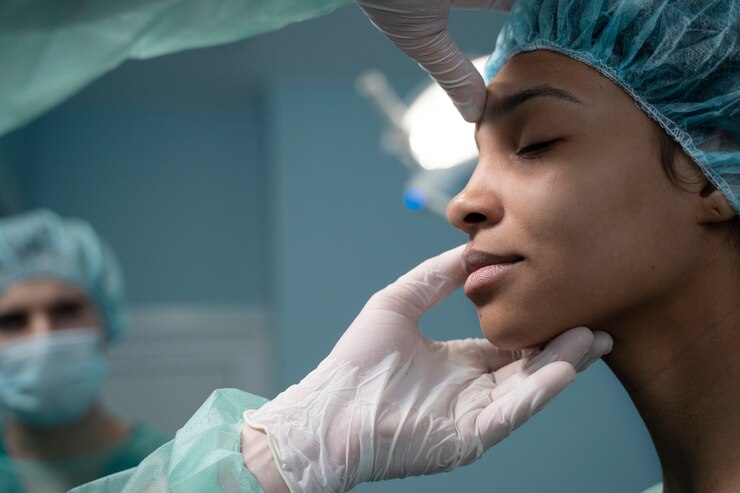Nose tip plasty, often a component of rhinoplasty, is a surgical procedure that aims to refine and enhance the nasal tip for improved facial aesthetics. While the surgical procedure is crucial for achieving the desired results, the recovery process is equally important in ensuring optimal outcomes. Understanding what to expect during recovery can help patients navigate this critical phase with confidence and patience.
Initial Recovery Period
The initial recovery period after Nose Tip Plasty In Dubai is vital and typically spans the first two weeks following the surgery. This phase is characterized by swelling, bruising, and some discomfort.
First 24 to 48 Hours
During the first day or two post-surgery, patients will experience the most intense symptoms related to the procedure.
- Post-Operative Care: After the surgery, patients are monitored in a recovery area for a few hours before being allowed to go home. It is crucial to have a friend or family member accompany them, as they may feel groggy from anesthesia.
- Swelling and Bruising: Swelling and bruising are common and expected. The nasal tip and surrounding areas may appear swollen and discolored. Patients can manage this by applying cold compresses gently around the nose to reduce swelling and alleviate discomfort.
- Pain Management: Mild pain and discomfort are typical after the procedure. Prescribed pain medications can help manage this discomfort, and patients should adhere strictly to the surgeon’s instructions regarding medication use.

Diet and Hydration
During the first few days following surgery, staying hydrated and consuming light, nutritious meals is essential. Patients may find it more comfortable to eat soft foods, especially if they experience any discomfort while chewing.
The First Week Post-Surgery
Swelling and Bruising Management
- Peak Swelling: Swelling usually peaks around the third or fourth day after surgery. This is a normal part of the healing process, and patients should not be alarmed if their nose appears larger than expected.
- Cold Compresses: Continuing to use cold compresses during this period can significantly aid in reducing swelling. However, patients should take care to avoid direct pressure on the nose.
Gradual Improvement
- End of First Week: By the end of the first week, most patients will notice a significant reduction in swelling and bruising. Although some residual swelling may persist, the overall appearance of the nose will begin to improve.
- Activity Levels: During this week, patients should limit physical activity to allow for optimal healing. Activities that may strain the nasal area, such as vigorous exercise or bending over, should be avoided.
Two Weeks Post-Surgery
After the first week, patients typically experience continued improvement in swelling and bruising.
Returning to Normal Activities
- Follow-Up Appointment: A follow-up appointment with the surgeon is usually scheduled around the two-week mark. During this appointment, the surgeon will assess the healing process and may remove any sutures if necessary.
- Increased Activity: Patients may gradually resume light activities, but they should still avoid strenuous exercises or contact sports that could impact the nose.
Monitoring Healing
- Nasal Care: Patients should follow their surgeon’s guidelines regarding nasal care. This may include gentle cleaning of the nasal area and using saline sprays to keep the nasal passages moist.
- Pain Management: Any lingering discomfort can usually be managed with over-the-counter pain relievers, but patients should consult their surgeon if they have concerns.
Long-Term Recovery: Weeks Three to Six
As the recovery progresses, patients can expect significant changes in the appearance of their nose.
Ongoing Swelling Reduction
- Continued Improvement: Swelling may persist for several weeks but will gradually diminish. Most swelling should resolve within three months, though subtle changes may continue for up to a year as the tissues settle into their new position.
- Final Results: By the six-month mark, patients can generally see a clearer picture of the final results of their nose tip plasty. However, it’s essential to remember that the final outcome can take up to a year to fully materialize.
Resuming Normal Activities
- Return to Exercise: Most patients can resume their regular exercise routines within four to six weeks post-surgery, depending on their surgeon's recommendations.
- Sun Protection: Protecting the nose from sun exposure is crucial during the recovery period, as sunburn can lead to pigmentation changes in the healing skin. Patients should use sunscreen and wear hats or sunglasses when outdoors.
Tips for a Smooth Recovery
Follow Your Surgeon’s Instructions
Adhering to the post-operative care instructions provided by the surgeon is vital. This may include advice on pain management, activity restrictions, and specific care for the surgical site.
Maintain a Healthy Diet
Eating a balanced diet rich in vitamins and minerals can support healing. Foods high in vitamin C, zinc, and protein can be particularly beneficial.
Stay Hydrated
Staying well-hydrated can help facilitate the healing process and reduce swelling.
Limit Alcohol and Smoking
Avoiding alcohol and smoking during the recovery period is crucial, as these can interfere with the healing process and increase the risk of complications.
Be Patient
Recovery is a gradual process, and it’s essential for patients to be patient with themselves as they heal. Emotional and physical changes may occur, and giving the body the time it needs to heal is important.
Signs of Complications
While most patients recover without issues, it is important to be aware of signs that could indicate complications.
Increased Pain or Swelling
If pain or swelling worsens significantly or persists beyond the expected timeframe, patients should contact their surgeon.
Signs of Infection
Redness, increased warmth, or discharge from the surgical site could indicate an infection. Prompt attention from a medical professional is necessary in such cases.
Breathing Difficulties
If patients experience difficulty breathing through their nose or notice any significant changes in their breathing patterns, they should seek medical advice immediately.
Conclusion
The recovery process after nose tip plasty is a critical phase that requires careful attention and patience. By understanding what to expect and following post-operative care instructions, patients can help ensure a smooth recovery and achieve the desired aesthetic results. It's important to remember that healing takes time, and staying in close communication with the surgical team will provide the best chance for a successful outcome. With proper care and management, individuals can look forward to enjoying the benefits of their nose tip plasty for years to come.





Comments